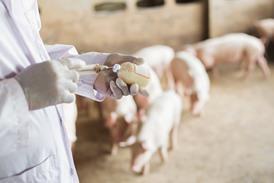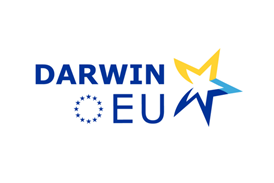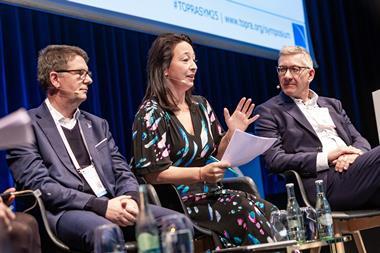Axicabtagene ciloleucel (tradename YESCARTA) is an autologous chimeric antigen receptor T-cell (CAR-T) therapy that targets CD19 and is approved for the treatment of aggressive, relapsed or refractory forms of B-cell non-Hodgkins lymphoma (NHL). The active substance is composed of a patient’s cells that have undergone ex vivo modification, which causes the T-cells to express an anti-CD19 directed CAR. CD19 is expressed as a surface antigen in diffuse large B-cell lymphoma (DLBCL) and other aggressive B-cell lymphomas. These transduced T-cells are reinfused back into the patient from which they were taken, meaning that each infusion of axicabatagene ciloleucel is unique to each patient. [1] [2]
Primary efficacy data for the EU and US submissions came from study KTE-C19-101 (ZUMA-1), which was a single-arm, open-label, multicentre Phase I/II trial with two segments. In this study, 101 patients received an infusion of the intended dose of ~2x106 cells/kg of body weight. Patients had previously received an anti-CD20 monoclonal antibody and anthracycline. The primary efficacy endpoint was objective response rate per investigator and was also assessed by an independent review committee (IRC). Supportive safety data were provided from additional single-arm, open-label studies of doses ranging from ~0.5-2x106 cells/kg of body weight. Significant risks were also identified, including cytokine release syndrome (CRS) and neurologic toxicities, including fatal cases.[1],[2]
Regulatory history and review
The EMA granted ODD for Yescarta for DLBCL, primary mediastinal large B-cell lymphoma (PMBCL) and follicular lymphoma (FL). Eligibility to PRIME was granted in May 2016 based on data from the ZUMA-1 study and from a separate, open-label Phase I study. An accelerated assessment procedure was agreed on in June 2017, and the MAA submitted in July 2017. During the assessment, the CAT concluded that it was no longer appropriate to maintain the accelerated assessment procedure, due to the adoption of a substantial list of questions and the need for a GCP inspection during the procedure. In June 2018, the CAT and the CHMP concluded that the efficacy demonstrated in the ZUMA-1 trial was sufficient to warrant approval. Comparisons were drawn to the retrospective global patient-level pooled study Scholar-1 in patients with aggressive forms of NHL. A post-authorisation safety study (PASS) was required to better characterise the safety profile in the post-marketing setting. The EMA also required steps to certify administration sites, including healthcare professional (HCP) training, patient education, and the availability of tocilizumab on site in order to manage any potential CRS occurrences.[1]
US regulatory history and review
In the US, axicabtagene ciloleucel was granted ODD for DLBCL (March 2014), as well as for PMBCL and FL (April 2016). Breakthrough therapy designation for refractory aggressive NHL was granted in December 2015. At a pre-BLA meeting in October 2016, the OTAT informed the sponsor that followup efficacy data longer than six months from the pivotal study would be needed to support the BLA. There were also fewer than the pre-specified number of subjects in the primary analysis. The sponsor initiated a rolling submission in December 2016. In May 2017, the FDA addressed the inadequacy of the follow-up duration in both the submitted data cuts; agreement was reached to submit updated efficacy data, which was completed in June 2017. At that point the FDA granted the BLA priority review. The agency did not request input from an advisory committee.
The FDA efficacy review noted concerns regarding the interpretability of results for time-to-event endpoints due to the open-label nature of the pivotal study. The FDA recommended that primary efficacy per the IRC be prioritised for regulatory decisions. Limitations were noted regarding the evaluation of duration of response due to a high amount of censoring of data before six months.[3] In October 2017, the FDA granted full approval of the BLA.48 The summary basis of approval highlights the adequate number of trial participants evaluated, the magnitude and durability of the treatment effect, and the high level of unmet medical need. Notably, a risk evaluation and mitigation strategy (REMS) with elements to assure safe use (ETASU) was deemed necessary. This REMS included a boxed warning concerning CRS and neurologic toxicities.[4] Administration site certification activities, including prescriber training and availability of tocilizumab, were included as requirements.[5] An observational study was required as a PMR to assess the long-term safety.[3]
Japan regulatory history and review
On 31 March 2020, a new drug application was submitted to the MHLW for review. In addition to the data packages submitted in the US and Europe, the Japanese submission included the results of a Phase II bridging study in Japanese patients with relapsed/refractory B-cell lymphomas.
Conclusions
Both EU and US regulators expressed an interest in understanding the durability of effect.[1],[2] Although data from an open-label study were used as the primary evidence of efficacy, the FDA clinical reviewer recommended that regulatory decisions focus on the results from the IRC rather than investigators. The conclusions were largely similar between the two agencies, with both requiring post-marketing assessment of the long-term safety of the product and specific risk-mitigation measures to certify sites to administer the product. Approved product labelling in the EU describes findings from the retrospective metaanalysis SCHOLAR-1.[6] Although this meta-analysis was also submitted in the US BLA, it is not referenced or discussed in the USPI.[2],[4] We await the Japanese assessment to determine their focus.
[1] EMA. Assessment report YESCARTA; CHMP; 22 June 2018. Available at: www.ema.europa.eu/en/documents/assessment-report/ yescarta-epar-public-assessment-report_en.pdf (accessed 21 May 2020).
[2] FDA. Food and Drug Administration: BLA clinical review memorandum. Available at: www.fda.gov/vaccines-blood-biologics/ cellular-gene-therapy-products/yescarta-axicabtagene-ciloleucel (accessed 25 March 2020).
[3] FDA. BLA approval. Available at: www.fda.gov/media/108458/ download (accessed 21 May 2020).
[4] Yescarta prescribing information. Available at: www.fda.gov/files/ vaccines%2C%20blood%20%26%20biologics/published/PackageInsert—YESCARTA.pdf (accessed 21 May 2020).
[5] FDA. Food and Drug Administration: risk evaluation and mitigation strategy (REMS) memorandum. Available at: www.fda.gov/ vaccines-blood-biologics/cellular-gene-therapy-products/yescartaaxicabtagene-ciloleucel (accessed 25 March 2020).
[6] EMA. Yescarta summary of product characteristics. Available at: www.ema.europa.eu/en/documents/product-information/yescartaepar-product-information_en.pdf (accessed 21 May 2020).































